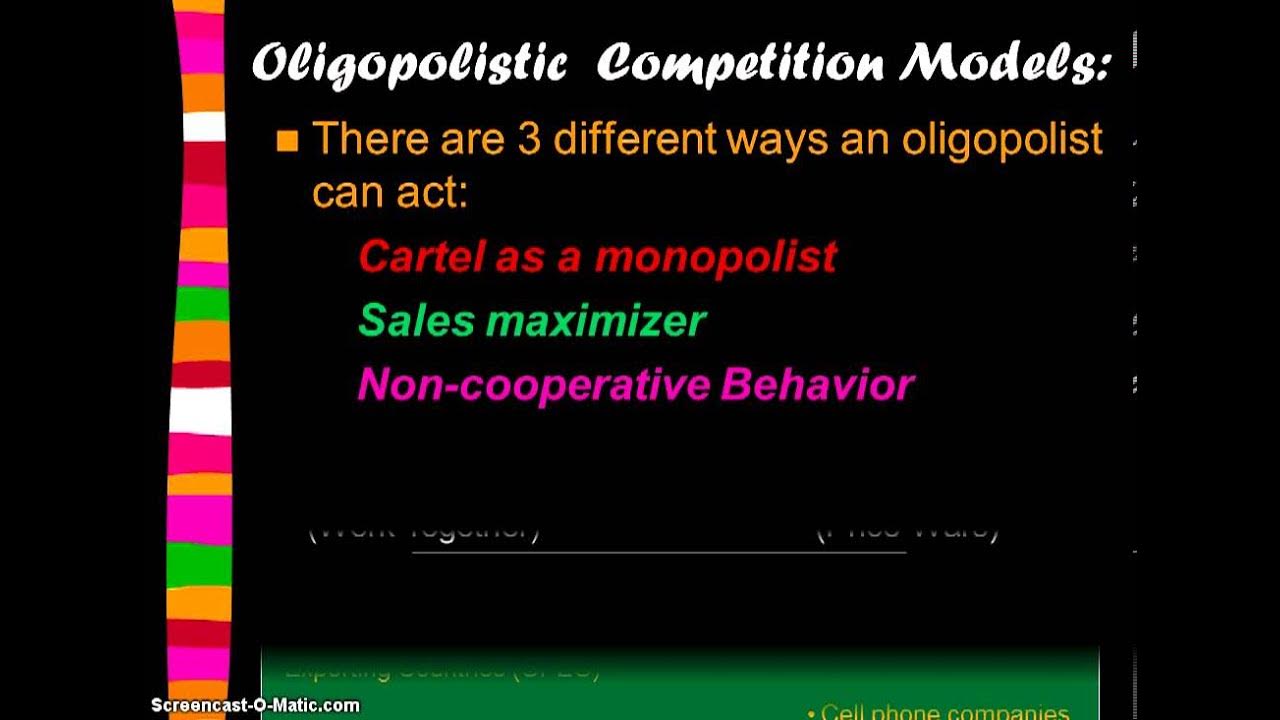PASAR OLIGOPOLI | KELOMPOK 6 | PENGANTAR EKONOMI | MANAJEMEN SEMESTER 1
Summary
TLDRThis presentation discusses the concept of oligopoly, a market structure dominated by a few firms that have the power to influence prices and production decisions. Key characteristics include a small number of firms, product differentiation or homogeneity, and interdependent decision-making. The analysis covers competition both in price and non-price factors such as advertising and customer service. The factors leading to oligopoly formation, such as economies of scale and high entry barriers, are highlighted. Additionally, models like the Prisoner's Dilemma and game theory are explored to explain firms' strategic decisions in oligopolistic markets.
Takeaways
- 😀 Oligopoly is a market structure where only a few firms dominate, and each has the power to influence prices and production decisions.
- 😀 Oligopolistic markets are characterized by limited competition, with few firms controlling most of the market share.
- 😀 Products in an oligopoly may either be homogeneous (e.g., steel) or differentiated (e.g., automobiles, cigarettes).
- 😀 Firms in an oligopoly engage in strategic decision-making, where the actions of one firm affect the decisions of others.
- 😀 Non-price competition (e.g., advertising, after-sales service) is important in oligopoly markets alongside price competition.
- 😀 Barriers to entry, such as economies of scale and high capital requirements, prevent new firms from entering oligopolistic markets.
- 😀 The concentration ratio is used to measure the market power of dominant firms, indicating how much of the market is controlled by the top firms.
- 😀 In oligopoly, firms may adopt strategies like setting prices strategically to deter new competitors and maintain their dominant position.
- 😀 The Kurnot model of oligopoly explains how firms reach equilibrium when they cannot improve their position by changing output or price.
- 😀 Game theory (specifically the Prisoner's Dilemma) helps explain strategic decision-making in oligopoly markets, where firms may cooperate or compete.
- 😀 Oligopoly is situated between perfect competition and monopoly, with firms balancing competitive pressures and strategic behavior to maximize profits.
Q & A
What is an oligopoly?
-An oligopoly is a market structure where a small number of firms dominate the market, allowing them to influence prices and production decisions. The firms' interactions with each other are crucial as their decisions affect the whole market.
What are the main characteristics of an oligopoly?
-The main characteristics of an oligopoly include few firms in the industry, interdependent decision-making, the possibility of homogeneous or differentiated products, and non-price competition such as advertising and customer service.
What is the significance of concentration ratios in an oligopoly?
-Concentration ratios measure the dominance of a few firms in the market. A high concentration ratio indicates that a small number of firms control a significant portion of the market, which is a defining feature of oligopolistic markets.
How do firms in oligopolies compete with each other?
-Firms in oligopolies can compete through price competition, but often rely on non-price competition like advertising, product differentiation, after-sales service, and brand loyalty. This helps them avoid direct price wars.
What role does economies of scale play in oligopoly markets?
-Economies of scale allow larger firms to lower their per-unit costs by producing at a larger scale. This can create a barrier to entry for smaller firms, leading to a concentration of the market in the hands of a few dominant firms.
What is price rigidity in oligopolistic markets?
-Price rigidity refers to the phenomenon where prices in oligopoly markets are resistant to change. Firms in an oligopoly often hesitate to raise or lower prices, fearing that such changes will lead to competitive disadvantages or price wars.
What is the kinked demand curve theory in oligopolies?
-The kinked demand curve theory suggests that oligopoly firms face a demand curve with a kink. If a firm raises its price, it will lose customers, but if it lowers its price, competitors will match the price reduction, making it ineffective.
How do firms in oligopolies predict competitors' reactions?
-Firms in oligopolies often predict competitors' reactions through strategic decision-making and market analysis. These predictions help firms set prices, output levels, and other strategic moves while avoiding detrimental competitive outcomes.
What is the relationship between oligopolies and barriers to entry?
-Oligopolies are characterized by high barriers to entry, such as large capital requirements, economies of scale, and complex management. These barriers prevent new firms from entering the market and competing with established firms.
How does game theory apply to oligopolies?
-Game theory helps explain the strategic behavior of firms in oligopolies, particularly how they make decisions based on expected reactions from competitors. For example, the 'Prisoner's Dilemma' model illustrates how firms may choose to cooperate or compete based on anticipated payoffs.
Outlines

This section is available to paid users only. Please upgrade to access this part.
Upgrade NowMindmap

This section is available to paid users only. Please upgrade to access this part.
Upgrade NowKeywords

This section is available to paid users only. Please upgrade to access this part.
Upgrade NowHighlights

This section is available to paid users only. Please upgrade to access this part.
Upgrade NowTranscripts

This section is available to paid users only. Please upgrade to access this part.
Upgrade Now5.0 / 5 (0 votes)





